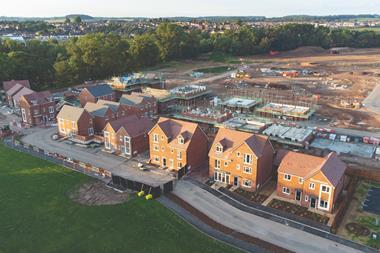In 2008, when I first started at calfordseaden as a graduate design engineer, local planning authorities and developers were getting to grips with the recent introduction of climate change policy at a local level.

The regional ‘Local Plans’, such as the Greater London Authority’s (GLA) London Plan, were strategic blueprints setting out an integrated economic, environmental, transport and social framework for a certain area. They included policies that focused on energy efficiency and integration of renewable technology in new developments. As a result of this, developers were required, as a prerequisite of planning approval, to adopt a range of efficient measures and low-carbon technologies in order to ensure CO2 emissions were reduced to below the building regulations baseline.
Since then, climate awareness has increased hugely and there has been some focus on the construction sector, which contributes to 40% of carbon emissions globally. Local authorities have therefore started to adopt a more stringent approach to reduction targets, and energy policies are taking increasing precedence in the planning permission appraisal process.
A pre-development assessment of energy efficiency and CO2 emissions is now a material condition of a planning application. Developers must submit an energy strategy assessment document to demonstrate how their design proposals achieve the energy policy targets.
These documents serve two purposes. Firstly, they demonstrate to planning officers how the local energy policies have been met in the design proposals. If a strategy is deemed poor or non-compliant with the authority’s energy policies it could delay planning permission, or even lead to refusal. Planner’s officers then ensure the proposals are built by securing the energy strategy commitments through planning conditions or Section 106 agreements.
Secondly, the documents are then available for councils to evaluate their energy policy. The GLA has been doing just that, and has been using energy strategy assessments to evaluate the material outcomes of the policies currently in place. The information gathered is also used to shape future policies, including incremental reduction targets towards net-zero-carbon buildings and changing technology preferences.
The conclusions drawn by the GLA are that its policy targets have consistently been met, CO2 emissions have been reduced and the uptake of renewable technologies has been increased. The vast majority of recent CO2 reduction has been attributed specifically to the ‘Be Clean’ technologies of heat networks with combined heat and power (CHP).
Despite these claims of successful policy, I and other industry members often had a different experience. We have noticed a gap between the predictions of the energy strategy assessment and the actual performance of these technologies in practice. Working for a range of contractors and developers that design, build and operate heat networks, it is clear that many of the claims of high efficiency and CO2 reductions made in these energy strategy assessments are over-optimistic and do not reflect deliverable performance in practice.
Investigating underperformance
Calfordseaden began to be asked by clients to investigate the underperformance of supposedly low-energy developments and the resulting poor quality of heating service, overheating, high energy use and fuel costs.
To aid and strengthen this investigation, I decided to undertake a PhD at the University of Cambridge. My PhD and resulting thesis looked at whether the local energy policies that encouraged the adoption and implementation of energy efficient and CO2-reducing technologies actually led to a material reduction in CO2 emissions.
I sourced and analysed more than 100 energy strategy assessments using the London Development Database (LDD). I then systematically reduced the 100 down to 50 based on development size, type and low carbon technology selected, which are directly referenced in my research.
My analysis identified that the assessments lacked any robust technical, social or economic assessment of the complex technologies they were advocating. The justification for the use of technologies was not backed up by any quantitative data and was instead based on notional concepts of technology performance or suitability for the type of development.

To use an example, many technologies being promoted in these strategies were simply labelled ‘highly efficient’, or the sites as having a ‘high heat density’, but no verifiable figures were used to justify these claims. In an effort to comply with planning policy, the assessments used secondary references to confirm their statements, but these were predominantly based on ‘compliance guides’, which contain prescriptive guidance on which technologies to prioritise. This guidance is not particularly technical, it does not discuss the specific conditions that these complex technologies require to achieve optimum performance. There was no direction towards professional design standards that has been created from a tried and tested methodology.
The potential consequence of these inadequate engineering assessments is that an unrealistic expectation of deliverable performance in practice is created, leading to an inevitable energy performance gap. This is not completely surprising given that many of the authors of the assessments held no specialist design or engineering qualifications.
The research I undertook for my PhD led me to conclude that this prescriptive approach to energy planning policy discourages developers from adopting the technology based on context-specific assessments, whether technical, social or economic. It instead leaves developers so focused on adhering to the policies that a ‘compliance-over-performance’ attitude is created.
In short, the reduction in CO2 emissions that is being reported in many circumstances is unlikely to be achieved in practice; in some instances, the technologies may have even resulted in an increase in CO2 emissions.
Furthermore, the construction industry develops a credibility problem as doubts grow over its ability to deliver real CO2 reductions. Despite the growing industry and academic evidence of the ‘performance gap’, policy makers are not receiving much evidence-based feedback. Meanwhile, CO2 targets continue to grow, buoyed by the predicted, but unproved, savings written into energy strategy assessments.
Practical solutions
To solve this issue, robust assessment methodologies will need to be applied during the earliest stages of a project to ensure that the design approved at planning stage can be delivered in practice once it is passed to a main contractor.
The GLA, for its part, has published the new draft London Plan, which includes a new section in the ‘Be Seen’ energy hierarchy. The purpose of this stage is that developers will be required to report on the actual energy use of the building for at least five years post construction. This will provide a potential solution to the lack of feedback to policy makers regarding the actual performance of buildings in practice.
However, unless the feedback is acted on to improve the policy guidance and assessment methods at the earliest stages of the project, strategies are likely to continue to be driven by compliance rather than performance.
Meanwhile, the complexity of favoured technological solutions is increasing. For example, proposals are in place to lower the carbon emission factor (kgCO2/kWh) for grid electricity, to reflect the current mix of fuels and renewable energy within the national electricity grid. This reduction has led for the first time to electrical forms of heating having less of a CO2 impact than natural gas. The GLA has been an early adopter of these proposed emission factors, resulting in heat pumps now being the preferred technology to supply heat networks. Virtually overnight CHP, the mainstay of CO2 emissions reduction strategies, has become redundant.
These electrically fuelled heat pumps present designers with a new range of opportunities to deliver efficient heating solutions by harnessing a vast array of heat sources, from air, ground, water and recovered heat – such as from the London Underground or electrical substations.
However, ensuring that the high efficiency of these technologies is delivered in practice and at affordable fuel costs presents new challenges, especially owing to complex design needs and the higher cost of grid electricity (around four times that of natural gas).
If the day-to-day performance of the technology is lower than that stated in the energy strategy, the burden of cost will ultimately fall on end users – and many will have had no say in the adoption of the systems. An increase in fuel poverty may become an unintended consequence of a compliance-based energy policy and, for many, low carbon may not mean low cost.
Designers and developers must therefore take greater responsibility for ensuring that the proposed energy strategy is based on technically rigorous and impartial assessments. Otherwise the gap between predicted and actual performance will continue to be a barrier to achieving actual CO2 emission reductions.

About calfordseaden
1. calfordseaden is an award-winning multidisciplinary consultancy with over 75 years of experience across all sectors of the built environment.
2. Our highly qualified and collaborative teams deliver innovative projects that are backed by a solution-focused approach.
3. Quality and innovation are the backbone of our services. Our level 2 BIM accreditation and experience in MMC place us at the forefront of industry advances.
4. We are committed to reducing the impact on the environment and working to net zero carbon buildings.
5. We pride ourselves on our flexible responses to projects and our ability to develop innovative solutions.
Topics
Time for property to listen and learn
- 1
- 2
- 3
- 4
 Currently reading
Currently readingEnergy strategies must avoid ‘performance gap’
- 5
- 6
- 7




































No comments yet